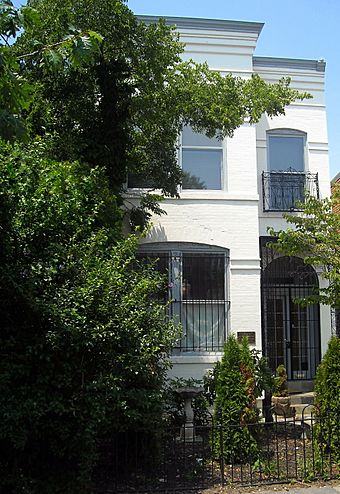Evans-Tibbs House facts for kids
Quick facts for kids |
|
|
Evans-Tibbs House
|
|
|
U.S. Historic district
Contributing property |
|
 |
|
| Location | 1910 Vermont Ave., NW Washington, D.C. |
|---|---|
| Built | 1894 |
| Architect | R.E. Crump |
| Architectural style | Late Victorian |
| Part of | Greater U Street Historic District (ID93001129) |
| NRHP reference No. | 86003025 |
| Added to NRHP | September 8, 1987 |
The Evans-Tibbs House is a special historic home located in the Shaw neighborhood of Washington, D.C.. It's known for its beautiful design and the important people who lived there. This house has been recognized as a historic site since 1985. It was also added to the National Register of Historic Places in 1987. The house is a key part of the larger Greater U Street Historic District.
Contents
Meet Lillian Evanti
A Famous Opera Singer
The Evans-Tibbs House was the home of Lillian Evans Tibbs for many years. She lived there from 1904 to 1967. Lillian Evans Tibbs was a very talented opera singer. She performed under the stage name Madame Lillian Evanti. She became one of the first African American opera singers to gain international fame.
Breaking Barriers in Music
Madame Lillian Evanti was a true pioneer. She was the first African American to perform with a European opera company. This was a huge achievement at the time. She even performed for Eleanor Roosevelt at the White House. Besides her singing, Tibbs also served as a Goodwill Ambassador to South America. In 1942, she helped create the National Negro Opera Company. This company helped other African American opera singers.
A Legacy of Art
After Lillian Tibbs passed away, her grandson, Thurlow Evans Tibbs, Jr., lived in the house. He opened an art gallery there called the Evans-Tibbs Collection. This gallery showed many wonderful pieces of art. When he passed away in 1997, his art collection was given to the Corcoran Gallery of Art. Later, in 2014, this collection moved to the National Gallery of Art.
House Design and History
Building Details
The Evans-Tibbs House is a two-story brick rowhouse. A rowhouse is a home that shares walls with other houses on both sides. The house was designed by an architect named R.E. Crump. It was built in 1894.
Special Features
In 1932, the house got some beautiful new additions. Decorative iron railings were added to the house. These railings have a unique design that looks like stylized harps. This detail adds to the house's charm and history.



